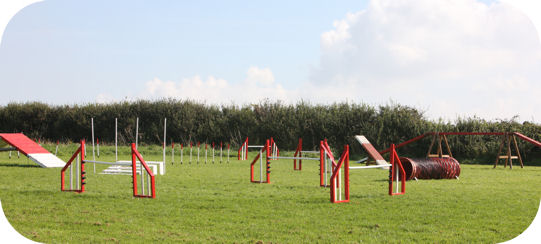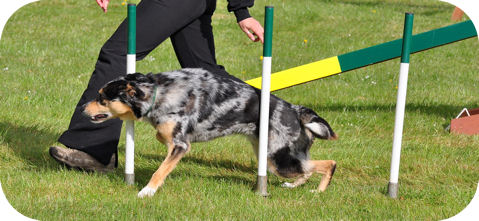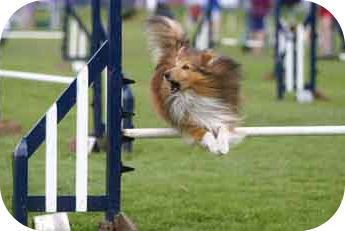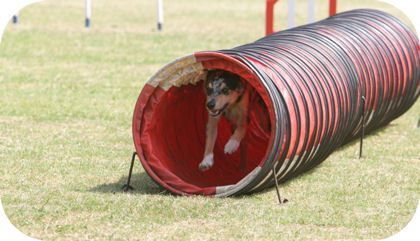Agility Equipment
Agility courses consist of various different obstacles which challenge your dog in different ways. All test your dog's technical ability in being agile and when put together as a series of obstacles the handlers ability is tested to direct the dog around a course in the fastest time with the least faults.

A course is typically between 16 and 20 obstacles and includes the following . . .
Weaves
The weaves consist of up to 12 poles in an upright position which are spaced approximately 20 inches apart. Your dog must always enter the weaves with their left shoulder adjacent to the first pole. This is regardless of whether you, the handler, are on the dogs left or right hand side. There are various methods of teaching weaves - traditional competition upright weaves, 'V' weaves, channel weaves and the 2 by 2 method.
At BaDDogz we have used our experience in teaching many dogs the weaves to devise our own unique weave training method which combines the advantages of all four methods outlined above. Using our weave training method, even dogs and handlers who have never done agility before can have independent weaves in just a few sessions.

Robbie weaving at Kernow K9 Agility Show in April 2009
Photo courtesy of Julie Adams
Most agility competitors will say that weaves are one of the most difficult items of agility equipment to teach, but with a proven methods, good timing and great rewards - learning can be fast and fun!
A-Frame, Dog Walk and Seesaw
Your dog must make contact with both the 'up' and 'down' painted areas on the A-Frame, Dog Walk and See-Saw in order to avoid gaining faults. Many dogs are quite happy racing up contacts and leaping off the end above the marked contact point - but unfortunately this is where agility is not just about speed . . . it is about accuracy too!
There are several methods for teaching your dog to touch the contact points (most of which focus on the training the 'down' contact as this is the area that is most frequently missed if not trained properly) - 2o-2o (two on - two off) position, 4o (four off position, one-rear toe position and running contacts.
Troy demonstrates the 2o-2o contact position
At BaDDogz we assess your dog in terms of their structure and learning style to decide the technique that will benefit them the most. We believe that each contact training method has its own benefits and is best matched to dogs on an individual basis.
The seesaw is the final item of contact equipment that we teach. Prior to putting your dog over a full size seesaw our classes cover a number of preparation exercises. When your dog then does the full size seesaw they can perform it quickly and confidently!
Jumps
Dogs will certainly need to learn how to jump a hurdle if they wish to do agility as most courses consist of at least 10 jumps. However, even jumping can be quite complex. There are regular jumps (single jumps) and spreads (double jumps) and then there are different sequences performed with jumps - boxes, snakes, pull throughs and push throughs.

Jed jumping at Packington Show in May 2003 showing some of that Sheltie attitude!
In addition to all of this you will want your dog to work away and perform a straight line of jumps independently from you (particularly at the end of a course) as most people cannot run as fast as their dogs!
Tunnels
There are two types of tunnels in agility courses - pipe (or rigid) tunnels and flat (or cloth) tunnels. Dogs are taught to to pick up the entry to a tunnel from a distance so you do not need to run right up to each tunnel entrance! Dogs also need to learn to be confident enough to push themselves through a cloth tunnel which can be quite scary for some dogs. It is useful for dogs to be trained to be called off the obvious entry to a pipe tunnel and to be sent into the other, less obvious, entry.

Robbie coming out of the tunnel in one of his first ever agility runs at Rugby Show 2005
Photo courtesy of www.fotomedia.co.uk
At Baddogz we always let each dog takes its own time in progressing with tunnels as our experience shows that some dogs absolutely love them and need no encouragement, but quite often for the first couple of lessons dogs find them quite dark and scary. We never force any dog to do a tunnel, they are always allowed to take their time and figure out for themselves that tunnels are not scary . . . they are places where cheese, sausage and toys magically appear at the end of - wow! Once they have figured that out . . . then there is no stopping them!
Wait for it . . . there's a manic blue merle collie about to come steaming out of the tunnel!!!
Other Obstacles . . .
Additional obstacles which you will frequently encounter on agility courses are the the tyre and the long jump. Very ocassionally you will come across the wall (which Troy can be seen jumping at the top of this page) and the wishing well!